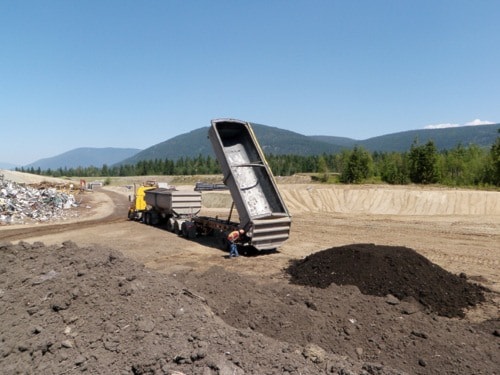The Thompson-Nicola Regional District is utilizing biosolids in the closure of its landfills - part of the Regional Solid Waste Management Plan’s project to replace them with more environmentally sound Eco-Depots.
These top-quality biosolids - compost-like material which contain microbes that naturally convert methane gas into carbon dioxide - will be trucked in from Metro Vancouver, and mixed with locally sourced chipped wood waste, sand and compost and used as landfill topsoil, and in landfill methane oxidation beds. Biosolids are treated organic solids recovered during the wastewater treatment process and are not harmful.
The TNRD is expecting to close the Barriere, Clearwater and Chase landfills in 2011.
They will be replaced with Eco Depots that accept the same material as landfills but do not bury material underground, rather collect and transfer waste and offer enhanced diversion opportunities intended to reduce the amount of garbage in the region.
“As we work towards closing our landfills and moving towards a more sustainable mode of waste management, residents are going to notice some changes in the near future,” said Don May, TNRD manager of Environmental Health Services. “These changes are working towards a greener way of life in the region for us, and generations to come.”
The biosolids are being trucked in on a daily basis to the Clearwater landfill until August, at Barriere until September, and Chase from August to October.
“With the biosolid mix in place in the methane oxidation beds, they reduce greenhouse gas emissions sent into the atmosphere by as much as 21 times,” added May.
In 2010 Metro Vancouver biosolids were used by the Columbia Shuswap Regional Districts at its Salmon Arm landfill. They also were used for progressive closure of steep slopes at TNRD landfills, and in methane oxidation bed pilot projects by TNRD at the Barriere and Lower Nicola landfills. The project was successful in capping the landfill and re-establishing a vegetative cover on the site.
The biosolids originate from the Iona and Annacis Island sewage treatment plants. A separate digestion process treats the biosolids once they are removed from the treatment plants. This process stabilizes the biosolids and removes pathogens while preserving the nutrient value of the biosolids - a critical requirement for composting. They are screened to remove plastics and other deleterious materials and meet stringent criteria required for the use of biosolids by the provincial Organic Matter Recycling Regulation.
This would not be the case for septage from septic tanks that contains considerable quantities of plastic and other waste materials that are not suitable for producing compost.
There is little sludge produced by aerated lagoons such as those in Clearwater because it is digested as part of the process. What remains has little nutrient value left for composting.
Metro Vancouver biosolids were used successfully in pilot studies on controlling methane generation from landfills and the regional district wanted to maintain the same mix of materials when scaling up to operational status.
– Submitted by TNRD
